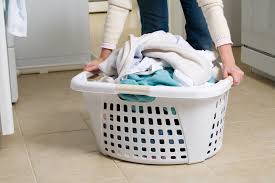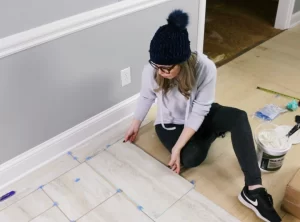Are you tired of looking at dirty peel and stick tiles in your home? Well, we’ve got good news for you – washing them is easier than you think!

In this article, we’ll show you how to properly clean peel and stick tiles to keep them looking fresh and beautiful. From the types of tiles that can be washed to the recommended cleaning products, we’ll cover everything you need to know.
So let’s roll up our sleeves and get those tiles sparkling clean!
Key Takeaways of Can You Wash Peel and Stick Tiles
- Regular cleaning is important for maintaining the appearance and longevity of peel and stick tiles.
- Use gentle cleaning methods and avoid harsh chemicals or abrasive scrubbers to prevent damage to the tiles and adhesive backing.
- Waterproof peel and stick tiles are suitable for areas with moisture, but proper cleaning methods are necessary to keep them looking their best.
- Sweep or vacuum the floor before washing to remove loose dirt or debris and prevent scratching the tiles.
Importance of Cleaning Peel and Stick Tiles
You’ll want to make sure you regularly clean your peel and stick tiles to maintain their appearance and longevity. Regular cleaning is essential for the upkeep of these tiles, as it helps prevent dirt, grime, and stains from building up over time. By taking the time to clean your peel and stick tiles on a regular basis, you can ensure that they continue to look their best for years to come.
The importance of regular cleaning cannot be overstated. Not only does it keep your tiles looking clean and fresh, but it also helps prolong their lifespan. When dirt or spills are left unattended, they can lead to discoloration or even damage the adhesive backing of the tiles.

To achieve effective cleaning without causing any harm, it is recommended to use gentle cleaning methods. Avoid using harsh chemicals or abrasive scrubbers that could potentially scratch or strip away the top layer of the tiles. Instead, opt for mild cleaners and soft cloths or sponges to gently remove any dirt or stains.
Types of Peel and Stick Tiles That Can Be Washed
When it comes to peel and stick tiles, one key consideration is whether they are waterproof. Waterproof peel and stick tiles offer an added level of protection against water damage, making them suitable for areas like bathrooms and kitchens where moisture is common.

However, even with waterproof tiles, proper cleaning methods are still necessary to maintain their appearance and longevity. In this discussion, we will explore the different types of waterproof peel and stick tiles available as well as effective cleaning methods to keep them looking their best.
Waterproof Peel and Stick
Peel and stick tiles are waterproof, so they can be easily washed. This makes them a great choice for areas where water is present, such as bathrooms and kitchens.
When it comes to cleaning these types of tiles, there are a few tips to keep in mind. First, make sure to sweep or vacuum the floor before mopping to remove any loose dirt or debris.
of tiles, there are a few tips to keep in mind. First, make sure to sweep or vacuum the floor before mopping to remove any loose dirt or debris.
Next, mix a mild detergent with warm water and use a mop or sponge to clean the tiles. Avoid using abrasive cleaners or scrub brushes as they can damage the surface.
After mopping, rinse the floor with clean water and dry it thoroughly. By following these simple cleaning tips, your waterproof peel and stick tiles will continue looking fresh and new for years to come!
Cleaning Methods for Tiles?
To clean your waterproof peel and stick tiles effectively, start by sweeping or vacuuming the floor to remove any loose dirt or debris. This will prevent scratching when you begin washing them. When it comes to cleaning different types of tile materials, it’s important to avoid common cleaning mistakes that can damage the surface. For example, using abrasive cleaners on delicate tiles like ceramic or glass can cause scratches. Additionally, using too much water on wood or laminate tiles can lead to warping or swelling. To help you navigate through the do’s and don’ts of tile cleaning, here is a handy table outlining some common tile materials and their recommended cleaning methods:
| Tile Material | Recommended Cleaning Method |
|---|---|
| Ceramic | Mild detergent and water |
| Glass | Non-abrasive glass cleaner |
| Porcelain | Vinegar and water mixture |
| Wood | Damp mop with hardwood cleaner |
| Laminate | Lightly damp mop with laminate cleaner |
Now that we have a better understanding of the types of tile materials and their corresponding cleaning methods, let’s move onto the steps to properly wash peel and stick tiles.
Steps to Properly Wash Peel and Stick Tiles
When it comes to cleaning techniques for tiles, it’s important to use methods that effectively remove dirt and grime without causing any damage.
We have found that a combination of gentle scrubbing with a soft brush or sponge and the use of mild cleaners or vinegar solutions work well for most tile surfaces.
However, it is crucial to avoid abrasive materials or harsh chemicals, as they can scratch or discolor the tiles.
Cleaning Techniques for Tiles
You can easily clean peel and stick tiles using a mixture of vinegar and water. This simple cleaning solution is effective in removing dirt, grime, and stains from the tiles without causing any damage to the adhesive. To clean your peel and stick tiles, follow these steps:
- Mix equal parts vinegar and water in a spray bottle.
- Spray the solution onto the tiles, focusing on any dirty or stained areas.
- Let the solution sit for a few minutes to loosen the dirt.
- Use a soft-bristle brush or mop to gently scrub the tiles.
- Wipe away any excess moisture with a clean cloth.
By regularly cleaning your peel and stick tiles using this method, you can maintain their appearance and extend their lifespan. Remember to avoid using abrasive cleaners or tools that may scratch or damage the surface of the tiles.
Emotional Response Table:
| Cleaning Tips | Maintaining Adhesive | Keeping Tiles Looking New |
|---|---|---|
| Effortless | Long-lasting | Fresh |
| Effective | Reliable | Vibrant |
| Time-saving | Secure | Pristine |
| Safe | Sturdy | Spotless |
| Affordable | Resilient | Gleaming |
Cleaning peel and stick tiles doesn’t have to be a daunting task when armed with these easy tips!
Avoiding Damage to Tiles
Avoid damaging your tiles by using gentle cleaning solutions and tools that won’t scratch or harm the surface.
When it comes to avoiding damage, it is important to choose the right cleaning products for your specific type of tile. For ceramic tiles, a mild detergent mixed with warm water is usually sufficient. Avoid harsh chemicals or abrasive cleaners as they can cause scratches or discoloration.
For natural stone tiles, such as marble or granite, it is recommended to use pH-neutral cleaners specifically designed for stone surfaces. These cleaners will effectively remove dirt and grime without causing any damage.
Additionally, be cautious when using tools like scrub brushes or scouring pads on your tiles, as they can also lead to scratches.
Recommended Cleaning Products for Peel and Stick Tiles
To clean peel and stick tiles, it’s best to use mild cleaning products that won’t damage the adhesive. Here are some recommended cleaning products that will effectively clean your peel and stick tiles without causing any harm:
- White vinegar: Mix equal parts of white vinegar and water to create a gentle yet effective cleaning solution.
- Dish soap: Dilute a few drops of dish soap in warm water for an easy and safe cleaning option.
- Isopropyl alcohol: This can be used for tougher stains or sticky residue on the tiles. Just apply a small amount on a cloth or sponge and gently scrub.
- Microfiber cloth: Use a microfiber cloth to wipe down the tiles after cleaning to remove any remaining dirt or debris.
- Soft-bristle brush: For stubborn stains, you can use a soft-bristle brush along with your chosen cleaning solution.
Using these types of cleaning products, along with proper techniques, will ensure that your peel and stick tiles stay clean and intact.
Now let’s discuss some common mistakes to avoid when washing peel and stick tiles.
Common Mistakes to Avoid When Washing Peel and Stick Tiles
When cleaning peel and stick tiles, it’s important to be mindful of the type of cleaning products used. Many people make common mistakes that can damage the tiles or compromise the adhesive.
One mistake is using harsh chemical cleaners, which can cause discoloration or even strip away the adhesive. It’s best to opt for mild, non-abrasive cleaners specifically designed for vinyl floors.
Another mistake is using excessive water when mopping. Too much water can seep into the seams and weaken the adhesive over time. Instead, use a damp mop or cloth to clean the tiles without saturating them.
Lastly, avoid scrubbing too vigorously as this can also damage both the surface of the tiles and their adhesive backing.
Tips for Maintaining the Adhesive on Peel and Stick Tiles
When it comes to maintaining the adhesive on peel and stick tiles, there are a few key points to consider.
Firstly, it is important to ensure that the water used for cleaning is compatible with the adhesive. Using water that is too hot or contains harsh chemicals can weaken the adhesive and cause it to lose its grip over time.
Secondly, employing proper cleaning techniques can greatly extend the longevity of the adhesive. This includes using gentle cleansers and non-abrasive tools to avoid damaging the surface or compromising the adhesive’s effectiveness.
Lastly, exploring alternative maintenance methods such as applying additional adhesives or sealants can help reinforce the bond between the tile and surface, providing extra durability and ensuring a longer lifespan for your peel and stick tiles.
Water and Adhesive Compatibility
You should be cautious about using too much water with peel and stick tiles because it may affect the adhesive’s effectiveness. Water can seep through the seams of the tiles and weaken the bond between the tile and the floor.
To ensure proper adhesive maintenance, here are some cleaning techniques to keep in mind:
- Use a damp cloth or mop: Avoid saturating the tiles with water. Instead, lightly dampen a cloth or mop to clean the surface.
- Use mild detergent: Avoid harsh chemicals that may damage the adhesive. Opt for a gentle soap or cleaner specifically designed for vinyl flooring.
- Spot clean spills immediately: Promptly wipe up any spills to prevent them from seeping into the seams and compromising the adhesive.
- Avoid excessive scrubbing: Scrubbing too vigorously can potentially loosen or damage the tiles’ adhesion.
- Dry thoroughly: After cleaning, make sure to dry the area completely to prevent any moisture from affecting the adhesive.
Cleaning Techniques for Longevity
To ensure the longevity of your peel and stick tiles, it’s important to follow these cleaning techniques.
When it comes to water and adhesive compatibility, it is crucial to strike a balance. While water can be used to clean the surface of the tiles, excessive moisture can weaken the adhesive bond over time.
To maintain the longevity of your peel and stick tiles, avoid using excessive amounts of water during cleaning. Instead, opt for a damp cloth or mop to gently wipe away dirt and grime.
For stubborn stains or spills, use a mild detergent diluted with water and a soft brush or sponge for gentle scrubbing. Remember to always dry the area thoroughly after cleaning to prevent any potential damage caused by lingering moisture.
Alternative Maintenance Methods
When it comes to maintaining peel and stick tiles, there are alternative cleaning methods that can be used. These methods not only keep the tiles clean and well-maintained but also minimize any potential damage. Here are some natural cleaning solutions you can try:
- Vinegar and water solution: Mix equal parts of vinegar and water in a spray bottle. This solution is effective for removing dirt and grime without harming the tiles.
- Baking soda paste: Make a paste using baking soda and water. Apply it to stubborn stains or scuffs on the tiles, then gently scrub with a soft cloth or sponge.
- Lemon juice: The acidic properties of lemon juice make it a great natural cleaner. Simply squeeze some lemon juice onto the stain and let it sit for a few minutes before wiping it away.
- Hydrogen peroxide: Dilute hydrogen peroxide with water and use this mixture to remove tough stains on the tiles.
- Essential oils: Add a few drops of your favorite essential oil to warm water for an aromatic floor cleaner.
By incorporating these alternative cleaning methods into your routine, you can maintain your peel and stick tiles effectively while keeping them safe from harsh chemical cleaners.
Now that we’ve covered how to clean peel and stick tiles using alternative methods, let’s move on to discussing how often you should wash them for optimal maintenance.
How Often Should You Wash Peel and Stick Tiles
If you’re wondering how often to wash peel and stick tiles, it’s important to consider the amount of foot traffic they receive. Frequency of cleaning peel and stick tiles can vary depending on the level of activity in the area where they are installed.
In high-traffic areas such as entryways or kitchens, it is recommended to clean these tiles more frequently, ideally once a week or as needed. However, for low-traffic areas like bedrooms or closets, cleaning them every two weeks should suffice.
When it comes to best practices for washing peel and stick tiles, there are a few things to keep in mind. First, make sure to sweep or vacuum the floor before mopping to remove any loose dirt or debris. Then, mix a mild detergent with warm water and use a mop or cloth dampened with this solution to gently scrub the tiles. Avoid using abrasive cleaners or excessive amounts of water, as these can damage the adhesive backing.
Can You Use Harsh Chemicals on Peel and Stick Tiles
Using harsh chemicals on peel and stick tiles can cause damage to their adhesive backing. It is important to be mindful of the cleaning methods you use to maintain these tiles. Here are some reasons why you should avoid harsh chemicals:
- Preserves Adhesive Strength: Harsh chemicals can weaken the adhesive, causing the tiles to lose their grip and potentially come loose.
- Prevents Discoloration: Certain chemicals may react with the tile’s surface, leading to discoloration or fading over time.
- Protects Surface Finish: Aggressive cleaners can strip away the protective finish on peel and stick tiles, leaving them vulnerable to scratches and stains.
- Maintains Longevity: Gentle cleaning methods help extend the lifespan of your peel and stick tiles, ensuring they look great for years.
- Promotes Healthier Indoor Environment: Harsh chemical fumes can be harmful when inhaled, so using safer cleaning alternatives is better for your overall well-being.
Alternative Methods for Cleaning Peel and Stick Tiles
There are alternative methods for cleaning peel and stick tiles that do not involve harsh chemicals. If you prefer to use natural cleaning methods, there are several effective options available. One option is to create a simple DIY solution using vinegar and water. Vinegar is known for its ability to remove dirt and grime without damaging the surface of the tiles. Another alternative cleaning solution is using baking soda paste. Baking soda is a gentle yet powerful cleaner that can help remove stains and odors from your peel and stick tiles. Additionally, steam cleaning can be an effective method for deep cleaning your tiles without the need for any chemicals at all.
Here is a table summarizing these alternative cleaning solutions:
| Method | Ingredients | Instructions |
|---|---|---|
| Vinegar Solution | 1 part vinegar, 3 parts water | Mix the ingredients in a spray bottle and spray onto the tiles. Wipe clean with a cloth or mop. |
| Baking Soda Paste | Baking soda, water | Mix enough water with baking soda to create a thick paste. Apply the paste to stained areas, let it sit for a few minutes, then scrub gently with a sponge or brush before rinsing off. |
| Steam Cleaning | Water | Use a steam cleaner on low heat setting to sanitize and clean your peel and stick tiles without any additional products needed. |
Pros and Cons of Washing Peel and Stick Tiles
One of the benefits of cleaning peel and stick tiles with alternative methods is that they are gentle on the surface. Regular cleaning is important to maintain the appearance and longevity of these tiles. Improper cleaning can potentially cause damage, such as peeling or discoloration.
Here are five items to consider when it comes to washing peel and stick tiles:
- Proper removal of dirt and grime: Gentle cleaning methods ensure that dirt and grime are effectively removed without causing any harm to the surface.
- Avoiding harsh chemicals: Alternative cleaning solutions help protect the integrity of the tiles by avoiding harsh chemicals that can strip away their adhesive properties.
- Preventing water damage: Excessive moisture can seep into the edges of peel and stick tiles, leading to warping or loosening. Using controlled amounts of water during cleaning helps prevent this potential damage.
- Maintaining a clean appearance: Regular cleaning not only removes visible stains but also prevents build-up, keeping your peel and stick tiles looking fresh and vibrant for longer.
- Extending their lifespan: By properly caring for your peel and stick tiles through regular gentle cleaning, you can extend their lifespan, saving you money in replacement costs.
Frequently Asked Questions
Can I Use a Steam Cleaner to Clean Peel and Stick Tiles?
Yes, you can use a steam cleaner to clean peel and stick tiles. However, it’s important to note that excessive heat and moisture may cause the adhesive to weaken. Therefore, we recommend using alternative methods such as gentle scrubbing with a mild cleanser or vinegar solution.
Can I Use Bleach or Vinegar to Clean Peel and Stick Tiles?
We’ve found that using bleach or vinegar is effective for cleaning peel and stick tiles. These natural solutions are great alternatives to harsh chemicals, leaving your tiles clean and shiny.
Can I Use a Scrub Brush or Abrasive Sponge to Clean Peel and Stick Tiles?
Yes, you can use a scrub brush or an abrasive sponge to clean peel and stick tiles. However, it’s important to avoid using harsh abrasives that may damage the tiles. Instead, opt for gentle cleaning solutions specifically designed for peel and stick tiles.
Can I Use a Mop or a Sponge Mop to Clean Peel and Stick Tiles?
Yes, you can use a sponge mop to clean peel and stick tiles. Simply dampen the mop with a cleaning solution and gently wipe the tiles. Avoid using excessive water or harsh chemicals that may damage the adhesive.
Can I Use a Pressure Washer to Clean Peel and Stick Tiles?
Using a pressure washer on peel and stick tiles can be risky. It’s best to avoid it as it may damage the tiles or cause them to peel off. Instead, try using alternative cleaning methods like a mop or sponge mop.
Conclusion
After learning about the importance of cleaning peel and stick tiles, the types that can be washed, and the steps to properly wash them, it is clear that maintaining cleanliness is crucial.
By using recommended cleaning products and avoiding common mistakes, one can keep their peel and stick tiles looking fresh for a long time. However, it is important to remember not to use harsh chemicals on these tiles.
In conclusion, like any other type of flooring, regular washing of peel and stick tiles will ensure their longevity and beauty in your home. So go ahead and give them a good wash – your floors will thank you!




